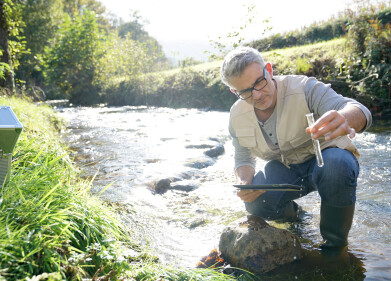-
 Jennifer Duhon
Jennifer Duhon
Environmental Laboratory
A guide to Proficiency Testing
Jul 08 2019
What is Proficiency Testing?
Proficiency Testing (PT) is the name used by the International Standards Organisation for a procedure also known as “inter-laboratory study” or “external quality assessment” or “ring test”. Proficiency testing, in simple terms, comprises a sample sent to a group of laboratories for measurement. The labs know what might be in the sample, but they don’t know exactly what is there or the concentration. Their results are compared with the known or true value and the lab is assigned a “Z” score to show how closely their result came to the target.
What is the purpose of PT?
The most common use for proficiency testing is to demonstrate to a regulatory body or an accreditation body, that a laboratory is capable and competent to perform a specific analytical test or technology. A second and sometimes overlooked benefit of Proficiency testing is as a critical tool for quality assurance and continuous improvement. Proficiency testing performed over time can give a laboratory a true picture of their testing quality, it can help a laboratory identify and realise continual improvement opportunities and can actually help a laboratory avoid nonconforming tests.
What are PT samples?
PT samples have specific analytes of interest, spiked in a particular matrix, in a concentration unknown to the participant. PT samples are fully tested and characterised by the provider prior to shipment. Each PT sample is supplied to the participant with a reporting packet which contains all of the critical information needed to perform the test such as the date range in which the test will be performed, instructions on how to report the data, any preparation or handling instructions, and the analyte ranges for the sample.
Who can make and distribute a PT sample?
Anyone can make and distribute a PT sample, but just any PT sample may not meet your needs. Most accrediting organisations require that providers of Proficiency testing be accredited to ISO17043:2010. Using a provider accredited to this standard enables laboratories analysing PT samples, and the users of the resulting data (accrediting bodies), a way to ensure that Proficiency testing was being completed in a meaningful and systematic manner.
What types of PTs are offered?
Merck produces environmental PT, pharmaceutical PT and technology based PT in several types of matrices, including neat materials, wastewater, drinking water, soil/sediment and air. PTs in a wastewater matrix are generally at higher levels similar to discharge samples while drinking water PTs are generally at lower ranges to mimic surface water and drinking water samples. PTs offered in a soil/sediment matrix vary and can include items such as petroleum compounds, metals or PCBs in the ranges that laboratories expect to see in polluted soils. An air PT may contain many of the same analytes that are in the water and soil samples but in impinger solution, on filter paper, PUF cartridges, air canisters or sorbent tubes. Pharmaceutical PTs are usually performed to demonstrate competency to USP general chapters and are generally neat materials. Technology PTs are used to prove competence to a specified technology, such as titration, pH, Karl Fischer, or Residue on Ignition.
What is required of a PT participant?
The participant’s role in the Proficiency testing process includes scheduling the samples for delivery, preparing and analysing the samples, and reporting the results back to the provider (Merck) by the reporting deadline. The participant will also need to review the final evaluation report and address any need for corrective action.
What is the PT provider’s role?
The provider will manufacture, test, and distribute the Proficiency testing samples. The provider will also provide any necessary information required to complete the test. Once the participant has supplied the analytical result, the provider will evaluate the data using criteria contained in ISO 17043:2010 and issue a report to each participant.
How are PTs scheduled?
Merck provides scheduled quarterly Proficiency tests, or quick-turn Proficiency tests. Scheduled quarterly PTs are run on pre-defined dates on a quarterly basis (4 times per year). The dates are determined and published at the beginning of each calendar year. These tests take place over a defined period of 45 days and the final reports are distributed to the participant approximately 21 days after the close date of the study.
As stated, most PT is run on a pre-defined schedule, meaning that your timeline is at the discretion of the PT Provider. This can be problematic, in certain situations, because of the schedule time between testing studies and the time it takes for the study to run and be evaluated. If a laboratory needs to expand their scope of accreditation, or has to perform a corrective action for a failure from a previous study, the lab would normally have to wait until the next scheduled study, and the whole evaluation process is completed. A Quick-Turn PT (QT-PT) is a proficiency test that is run at your convenience; you can request a Quick-Turn PT at any time. The ‘study’ is closed once the sample analysis is completed, and your data is submitted to Merck. The results are then evaluated immediately, and final reports are sent out within 48 hours. Quick-Turn PT rounds are available for the majority of the Merck sample portfolio and are provided at the same price as the scheduled samples.
Merck has recently introduced a new proficiency-testing data-entry portal. The new portal can be accessed at Merck-pt.com and has been available since mid-July 2018. The new portal has been streamlined and will offer superior speed, ease of use, and data handling. Merck has been committed to updating and providing a user interface that is efficient, simple and something that meets the evolving needs of the end user. The result is our new data-entry portal which is easy to learn, easy to remember and easy to use.
Some of the features of the new Web portal:
• One-click design that is easy to navigate, even for first time users.
• All open studies prominently displayed on the home screen.
• Easily add new personnel/analysts to your lab.
• Add accreditors and enter data all on a single page.
• Easily copy down method/analyst/analysis date to all analytes in a sample.
• Data is actively saved as you report.
• A confirmation screen that shows exactly what you have entered and will be submitted for evaluation.
• Methods saved as default along with the option to add in house methods
• Calendar which will have open and close dates for studies customers are enrolled in
• A newly designed Frequently Asked Questions page
• Automated email reminders sent to customers 7 days before study closes
• Option to send results to a third party (i.e. Corporate QA Manager)
• Accreditors will be able to log in and download results at any
• Expand/collapse items for quick loading times
Data Tracking and Analysis using MyTrends and MyStats
All study data that was previously entered into the former PT portal has been transferred over to the new system. If you are a new user to the updated portal, you also now have the ability to import your historical data in order to perform data trending regardless of your previous PT provider. The addition of graphs to reports also provides a new enhancement for all data processing needs.
Training on the new Portal
A webinar has been offered to demo the new portal and field any questions that you might have. If you didn’t have the opportunity to attend the webinar, a copy has been posted in the FAQ section of the PT Portal login page to view at your convenience.
Digital Edition
AET 28.3 September 2024
September 2024
Business News - ENVEA announces acquisition of APAQ Group - SICK and Endress+Hauser sign strategic partnership - Efforts to curb gas flaring intensify amid environmental concerns Air Monito...
View all digital editions
Events
Nov 06 2024 Ho Chi Minh City, Vietnam
Nov 12 2024 Tel Aviv, Israel
Nov 12 2024 Valencia, Spain
Nov 12 2024 Singapore
Plastics Recycling World Expo North America
Nov 13 2024 Cleveland, OH, USA


















